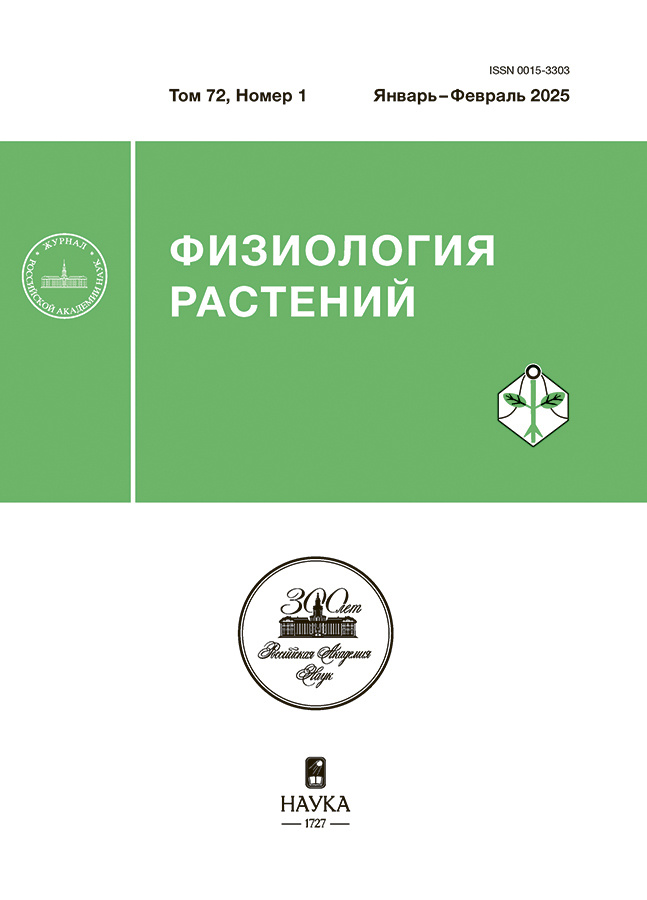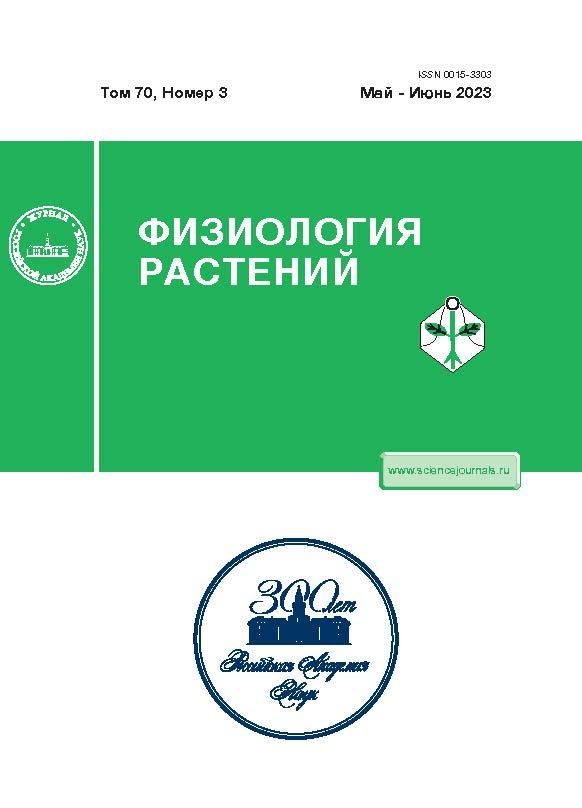Влияние продолжительности фотопериода на эффективность низкотемпературного закаливания Arabidopsis thaliana Heynh. (L.)
- Авторы: Попов В.Н.1, Дерябин А.Н.1
-
Учреждения:
- Федеральное государственное бюджетное учреждение науки Институт физиологии растений им. К.А. Тимирязева Российской академии наук
- Выпуск: Том 70, № 3 (2023)
- Страницы: 311-318
- Раздел: ЭКСПЕРИМЕНТАЛЬНЫЕ СТАТЬИ
- URL: https://cardiosomatics.ru/0015-3303/article/view/648170
- DOI: https://doi.org/10.31857/S0015330322600619
- EDN: https://elibrary.ru/IASUAI
- ID: 648170
Цитировать
Полный текст
Аннотация
Исследовали влияние продолжительности фотопериода на эффективность низкотемпературного закаливания растений Arabidopsis thaliana (L.) Heynh., экотип Col-0. Закаливание 6-недельных растений проводили при температуре 2°С в течение 1‒5 сут., используя фотопериоды 0, 8 и 16 ч (освещенность 200 мкмоль/(м2 с)). Показано, что растения, подвергнутые закаливанию в темноте, не были устойчивы к морозу, согласно данным по выживаемости и выходу электролитов после тестирующего промораживания (–6°C, 1 сут.). Растения, закаленные на свету (независимо от фотопериода), к концу периода закаливания значительно повысили свою морозоустойчивость. Отношение видимый фотосинтез/темновое дыхание у этих растений было почти в два раза выше, чем в контроле (без закаливания). Вариант с 16-часовым фотопериодом превосходил вариант с 8-часовым освещением, как по максимальным уровням накопления сахаров (почти на 40%), так и по скорости достижения этих уровней в посуточной динамике закаливания. Показано транзиторное увеличение содержания МДА в первые сутки закаливания на свету и отсутствие изменений в содержании МДА при закаливании в темноте, что может свидетельствовать о сигнальной функции продуктов перекисного окисления липидов при закаливании. Установлено влияние продолжительности фотопериода на скорость формирования устойчивости растений A. thaliana к морозу. Более длительная работа фотосинтетического аппарата A. thaliana при 16 ч фотопериоде значительно повышала скорость накопления сахаров при закаливании и, соответственно, скорость формирования устойчивости к морозу по сравнению с 8 ч фотопериодом. Заключено, что для быстрого формирования повышенной устойчивости A. thaliana к морозу требуется сочетание низкой положительной температуры и 16-часового фотопериода.
Об авторах
В. Н. Попов
Федеральное государственное бюджетное учреждение науки Институтфизиологии растений им. К.А. Тимирязева Российской академии наук
Автор, ответственный за переписку.
Email: vnpopov@mail.ru
Россия, Москва
А. Н. Дерябин
Федеральное государственное бюджетное учреждение науки Институтфизиологии растений им. К.А. Тимирязева Российской академии наук
Email: vnpopov@mail.ru
Россия, Москва
Список литературы
- Nievola C.C., Carvalho C.P., Carvalho V., Rodrigues E. Rapid responses of plants to temperature changes // Temperature. 2017. V. 4. P. 371. https://doi.org/10.1080/23328940.2017.1377812
- Larcher W. Physiological Plant Ecology. Ecophysiology and stress physiology of functional groups. Springer: Berlin, Heidelberg, New York, 2003. P. 513.
- Трунова Т.И. Растение и низкотемпературный стресс. 64-е Тимирязевские чтения. М.: Наука, 2007. 54 с.
- Theocharis A., Clement C., Barka E.A. Physiological and molecular changes in plants grown at low temperatures // Planta. 2012. V. 235. P. 1091. https://doi.org/10.1007/s00425-012-1641-y
- Rihan H.Z., Al-Issawi M., Fuller M.P. Advances in physiological and molecular aspects of plant cold tolerance // J. Plant Interact. 2017. V. 12. P. 143. https://doi.org/10.1080/17429145.2017.1308568
- Weiser C.J. Cold resistance and injury in woody plants: Knowledge of hardy plant adaptations to freezing stress may help us to reduce winter damage // Science. 1970. V. 169. P. 1269. https://doi.org/10.1126/science.169.3952.1269
- Maurya J.P., Bhalerao R.P. Photoperiod and temperature mediated control of growth cessation and dormancy in trees: a molecular perspective // Ann. Bot. 2017. V. 120. P. 351. https://doi.org/10.1093/aob/mcx061
- Wanner L.A., Junttila O. Cold-Induced Freezing Tolerance in Arabidopsis // Plant Physiology. 1999. V. 120. P. 391. https://doi.org/10.1104/pp.120.2.391
- Lee C.M., Thomashow M.F. Photoperiodic regulation of the C-repeat binding factor (CBF) cold acclimation pathway and freezing tolerance in Arabidopsis thaliana // PNAS. 2012. V. 109. P. 15054. https://doi.org/10.1073/pnas.1211295109
- Трунова Т.И. Световой и температурный режимы при закаливании озимой пшеницы и значение олигосахаридов для морозостойкости // Физиология растений. 1965. Т. 12. С. 85.
- Xin Z., Browse J. Cold comfort farm: the acclimation of plants to freezing temperatures // Plant Cell Environ. 2000. V. 23. P. 893. https://doi.org/10.1046/j.1365-3040.2000.00611.x
- Campos P.S., Quartin V., Ramalho J.C., Nunes M.A. Electrolyte leakage and lipid degradation account for cold sensitivity in leaves of Coffea sp. plants // J. Plant Physiol. 2003. V. 160. P. 283. https://doi.org/10.1078/0176-1617-00833
- Klimov S.V., Astakhova N.V., Trunova T.I. Changes in Photosynthesis, Dark Respiration Rates and Photosynthetic Carbon Partitioning in Winter Rye and Wheat Seedlings during Cold Hardening // J. Plant Physiol. 1999. V. 155. P. 734.
- Туркина М.В., Соколова С.В. Методы определения моносахаридов и олигосахаридов // Биохимические методы в физиологии растений / Под ред. Павлиновой О.А. М.: Наука, 1971. 7 с.
- Heath R.L., Packer L. Photoperoxidation in isolated chloroplasts. I. Kinetics and stoichiometry of fatty acid peroxidation // Arch Biochem. Biophys. 1968. V. 125. P. 189. https://doi.org/10.1016/0003- 9861(68)90654-1
- Zuther E., Schulz E., Childs L.H., Hincha D.K. Clinal variation in the non-acclimated and cold–acclimated freezing tolerance of Arabidopsis thaliana accessions // Plant Cell Environ. 2012. V. 35. P. 1860. https://doi.org/10.1111/j.1365-3040.2012.02522.x
- Catala R., Medina J., Salinas J. Integration of low temperature and light signaling during cold acclimation response in Arabidopsis // PNAS. 2011. V. 108 P. 16475. https://doi.org/10.1073/pnas.1107161108
- Ashworth E.N., Pearce R.S. Extracellular freezing in leaves of freezing-sensitive species // Planta. 2002. V. 214. P. 798. https://doi.org/10.1007/s00425-001-0683-3
- Reyes-Diaz M., Ulloa N., Zuniga-Feest A., Gutierrez A., Gidekel M., Alberdi M., Corcuera L.J., Bravo L.A. Arabidopsis thaliana avoids freezing by supercooling // J. Exp. Bot. 2006. V. 57. P. 3687. https://doi.org/10.1093/jxb/erl125
- Deryabin A.N., Trunova T.I. Colligative effects of solutions of low-molecular sugars and their role in plants under hypothermia // Biol Bull Russ Acad Sci. 2021. V. 48. P. 29. https://doi.org/10.1134/S1062359021060042
- Kreslavski V.D., Los D.A., Allakhverdiev S.I., Kuznetsov V.V. Signaling role of reactive oxygen species in plants under stress // Russ. J. Plant Physiol. 2012. V. 59. P. 141. https://doi.org/10.1134/S1021443712020057
- Foyer C.H., Noctor G. Redox regulation in photosynthetic organisms: signaling, acclimation and practical implications // Antioxid. Redox Signal. 2009. V. 11. P. 861. https://doi.org/10.1089/ars.2008.2177
- Shulaev V., Oliver D.J. Metabolic and proteomic markers for oxidative stress. New tools for reactive oxygen species research // Plant Physiol. 2006. V. 141. P. 367. https://doi.org/10.1104/pp.106.077925
- Mori I.C., Schroeder J.I. Reactive Oxygen Species Activation of Plant Ca2+ Channels: A Signaling Mechanism in Polar Growth, Hormone Transduction, Stress Signaling, and Hypothetically Mechanotransduction // Plant Physiol. 2004. V. 135. P. 702. https://doi.org/10.1104/pp.104.042069
- Pitzschke P., Hirt H. Mitogen Activated Protein Kinases and Reactive Oxygen Species Signaling in Plants // Plant Physiol. 2006. V. 141. P. 351. https://doi.org/10.1104/pp.106.079160
- Foyer C.H., Noctor G. Redox Homeostis and Antioxidant Signaling: A Metabolic Interface between Stress Perception and Physiological Responses // Plant Cell. 2005. V. 17. P. 1866. https://doi.org/10.1105/tpc.105.033589
- Soitamo A.J., Piippo M., Allahverdiyeva Y., Battchikova N., Aro E.M. Light has a specific role in modulating Arabidopsis gene expression at low temperature // BMC Plant Biology. 2008. V. 8. P. 13. https://doi.org/10.1186/1471-2229-8-13
- Kim H.J., Kim Y.K., Park J.Y., Kim J. Light signalling mediated by phytochrome plays an important role in cold-induced gene expression through the C-repeat/dehydration responsive element (C/DRE) in Arabidopsis thaliana // Plant J. 2002. V. 29. P. 693. https://doi.org/10.1046/j.1365-313x.2002.01249.x
- Crosatti C., Polverino de Laureto P., Bassi R., Cattivelli L. The interaction between cold and light controls the expression of the cold-regulated barley gene cor14b and the accumulation of the corresponding protein // Plant Physiol. 1999. V. 119. P. 671. https://doi.org/10.1104/pp.119.2.671
- Zhang R., Gonze D., Hou X., You X., Goldbeter A. A computational model for the cold response pathway in plants // Frontiers in physiology. 2020. V. 11. e591073. https://doi.org/10.3389/fphys.2020.591073
- Zhao C., Zhang Z., Xie S., Si T., Li Y., Zhu J.K. Mutational evidence for the critical role of CBF transcription factors in cold acclimation in Arabidopsis // Plant Physiol. 2016. V. 171. P. 2744. https://doi.org/10.1104/pp.16.00533














